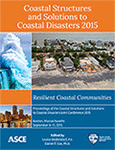Coastal Structures and Solutions to Coastal Disasters Joint Conference 2015
Numerical Investigation of Developed and Undeveloped Barrier Island Response to Hurricane Sandy
Publication: Coastal Structures and Solutions to Coastal Disasters 2015: Resilient Coastal Communities
ABSTRACT
Hurricane Sandy destroyed coastal areas along the Atlantic Coast of the U.S.A. upon making landfall on 29 October 2012. High storm surge and waves caused severe overwash and breaching on both uninhabited and developed barrier islands. In this study, we evaluate the extent to which erosion is affected by infrastructure using the numerical model XBeach. Several scenarios are simulated to represent Mantoloking and Bay Head, which are neighboring townships on an urbanized New Jersey barrier island: the ‘developed’ scenarios include buildings and a buried seawall as they existed in their pre-storm conditions, and the ‘abandoned’ scenarios exclude the buildings and the seawall. Comparing these scenarios, we determine the seawall greatly reduces erosion on the dune and landward side, but erosion is exacerbated by buildings due to flow channelization. When both buildings and the seawall are removed, the barrier island is completely inundated and overwashed into the bay, indicating a landward migration of the island. These results show coastal infrastructure can have extreme effects on barrier island response to storm events.
Get full access to this article
View all available purchase options and get full access to this chapter.
ACKNOWLEDGEMENTS
This research was supported by the National Oceanic and Atmospheric Administration, U.S. Department of Commerce, under Award No. NA14OAR4170093 to Virginia Sea Grant, National Science Foundation via grant #EAR-1312813, and National Science Foundation Graduate Research Fellowship program under grant #DGE-1148903. J. den Bieman and A. van Dongeren are supported through Deltares Research Program on “Hydro- and Morphodynamics during extreme events”. The authors thank Dr. Philip Orton, Stevens Institute of Technology, for providing surge data from sECOM simulations. The authors acknowledge Advanced Research Computing at Virginia Tech for providing computational resources and technical sup- port that have contributed to the results reported within this paper. URL: http://www.arc.vt.edu.
REFERENCES
Blake, E. S., Kimberlain, T. B., Berg, R. J., Cangialosi, J., Beven II, J. L. (2013). “Tropical cyclone report: Hurricane Sandy”. National Hurricane Center, 12, 1–10.
Booij, N., Ris, R., Holthuijsen, L. H. (1999). “A third-generation wave model for coastal regions: 1. model description and validation.” Journal of Geophysical Research: Oceans (1978–2012), 104, 7649–7666.
Claudino-Sales, V., Wang, P., Horwitz, M. H. (2008). “Factors controlling the survival of coastal dunes during multiple hurricane impacts in 2004 and 2005: Santa Rosa barrier island, Florida.” Geomorphology, 95, 295–315.
Houser, C., Hamilton, S. (2009). “Sensitivity of post-hurricane beach and dune recovery to event frequency.” Earth Surface Processes and Landforms, 34, 613–628.
Irish, J. L., Lynett, P. J., Weiss, R., Smallegan, S. M., Cheng, W. (2013). “Buried relic seawall mitigates Hurricane Sandy’s impacts.” Coastal Engineering, 80, 79–82.
McCall, R., De Vries, J. V. T., Plant, N., Van Dongeren, A., Roelvink, J., Thompson, D., Reniers, A. (2010). “Two-dimensional time dependent hurricane overwash and erosion modeling at Santa Rosa Island.” Coastal Engineering, 57, 668–683.
National Data Buoy Center (2012). “Station 44025 (LLNR 830) - Long Island - 30 NM South of Islip, NY.” National Oceanic and Atmospheric Administration. http://www.ndbc.noaa.gov/station page.php?station=44025 (September 26, 2014).
National Geophysical Data Center (2013). “National Geophysical Data Center, U.S. Coastal Relief Model.” National Oceanic and Atmospheric Administration. http://www.ngdc.noaa.gov/mgg/coastal/crm.html (August 21, 2013).
National Water Information System (2012). “USGS 01408168 Barnegat Bay at Mantoloking NJ.” U.S. Geological Survey. http://waterdata.usgs.gov/usa/nwis/uv?01408168 (January 14, 2014).
Orton, P., Georgas, N., Blumberg, A., Pullen, J. (2012). “Detailed modeling of recent severe storm tides in estuaries of the New York City region.” Journal of Geophysical Research: Oceans (1978–2012), 117.
Roelvink, D., Reniers, A., Van Dongeren, A., De Vries, J. V. T., McCall, R., Lescinski, J. (2009). “Modelling storm impacts on beaches, dunes and barrier islands.” Coastal Engineering, 56, 1133–1152.
Smallegan, S. M., Irish, J. L., Van Dongeren, A. R., Den Bieman, J. P. (in review). “Morphological response of a sandy barrier island with a buried seawall during Hurricane Sandy.”
The Richard Stockton Coastal Research Center (2012). “Beach-dune Performance Assessment of New Jersey Beach Profile Network (NJBPN) Sites at Northern Ocean County, New Jersey After Hurricane Sandy Related to FEMA Disaster DR-NJ 4086.” Technical Report. The Richard Stockton College of New Jersey. Pomona, NJ.
U.S. Army Corps of Engineers (2010). “2010 USACE lidar: New Jersey.” http://www.csc.noaa.gov/digitalcoast/data/coastallidar/download (July 31, 2013).
U.S. Geological Survey (2012). “2012 USGS EAARL-B Lidar: Pre- Sandy (NJ).” St. Petersburg Coastal and Marine Science Center. http://www.csc.noaa.gov/digitalcoast/data/coastallidar/download (June 30, 2014).
U.S. Geological Survey (2015). “National assessment of storm-induced coastal change hazards: pre- and post-storm photo comparisons.” St. Petersburg Coastal and Marine Science Center, U.S. Geological Survey, http://coastal.er.usgs.gov/hurricanes/ sandy/photo-comparisons (October 29, 2015).
Woodruff, J. D., Irish, J. L., Camargo S. J. (2013). “Coastal flooding by tropical cyclones and sea-level rise.” Nature, 504, 44–52.
Wright, C. W., Troche, R. J., Klipp, E. S., Kranenburg, C. J., Fredericks, A. M., Nagle, D. B. (2014). “EAARL-B submerged topography: Barnegat Bay, New Jersey, pre-Hurricane Sandy, 2012.” Technical Report Data Series 885. U.S. Geological Survey. http://pubs.er.usgs.gov/publication/ds885 (November 14, 2014).
Information & Authors
Information
Published In
Coastal Structures and Solutions to Coastal Disasters 2015: Resilient Coastal Communities
Pages: 74 - 79
Editors: Louise Wallendorf, U.S. Naval Academy and Daniel T. Cox, Ph.D., Oregon State University
ISBN (Online): 978-0-7844-8030-4
Copyright
© 2017 American Society of Civil Engineers.
History
Published online: Jul 11, 2017
Published in print: Jul 11, 2017
Authors
Metrics & Citations
Metrics
Citations
Download citation
If you have the appropriate software installed, you can download article citation data to the citation manager of your choice. Simply select your manager software from the list below and click Download.
